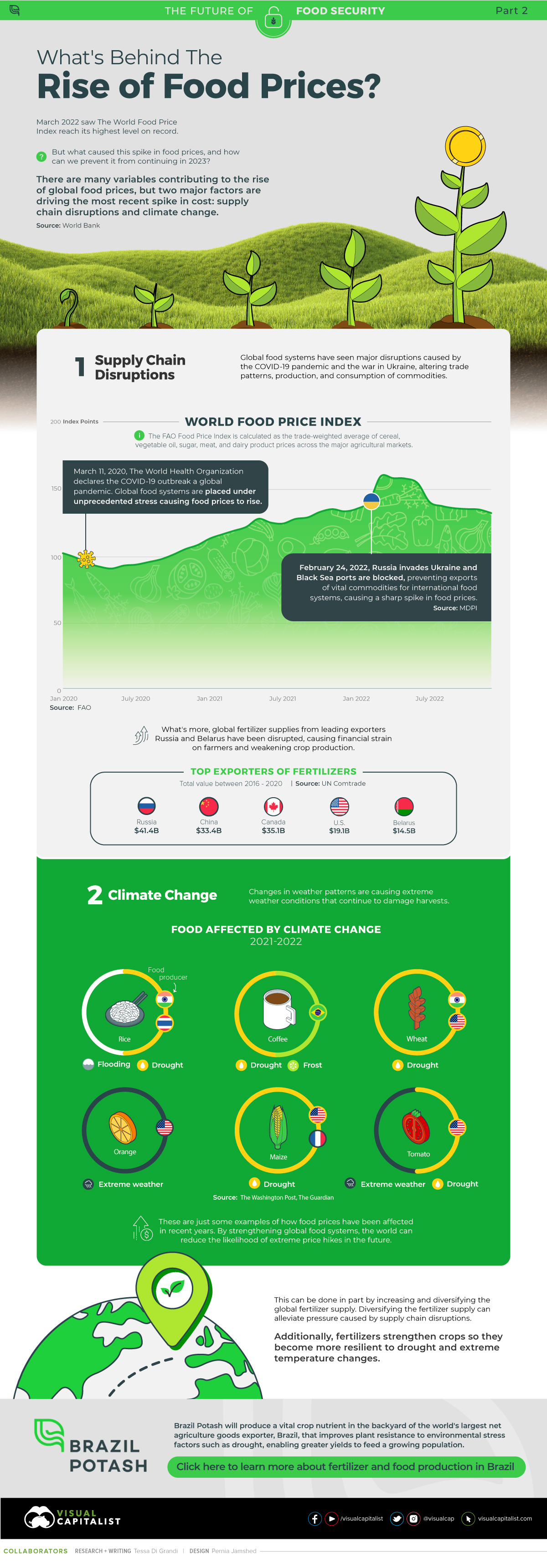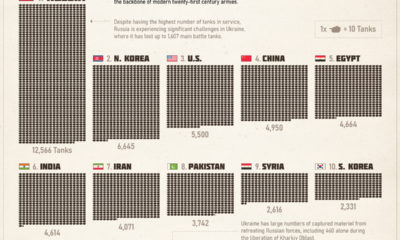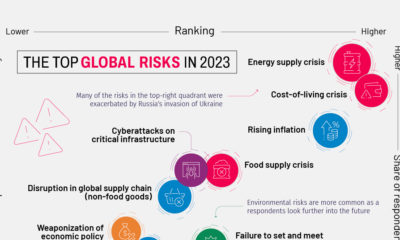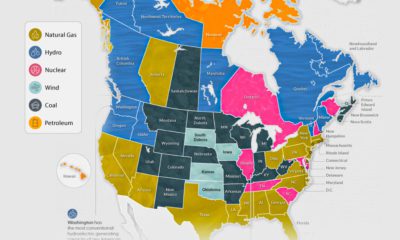
Written By Tessa Di Grandi
Graphics & Design
- Pernia Jamshed
Published January 17, 2023
•
Updated January 17, 2023
•
TweetShareShareRedditEmail
The following content is sponsored by Brazil Potash

The Rise Of Food Prices
The World Food Price Index reached an all-time high in March 2022 before gradually falling for nine months to December 2022. But what caused this surge?
There are many variables contributing to the rising cost of global food, but supply chain disruptions and climate change are two major drivers for the spike in prices over the most recent years.
The above graphic from Brazil Potash explores how these two factors are contributing to the most recent rise in food prices.
1. Supply Chain Disruptions
The COVID-19 pandemic and Russia’s invasion of Ukraine have caused major disruptions to global food systems, altering trade patterns, production, and consumption of commodities.
The pandemic placed unprecedented stress on global food systems through a variety of factors, including a change in consumer food consumption, workforce restrictions, and trade pattern disruptions, causing food prices to rise.
Then, on February 24, 2022, Russia invaded Ukraine, blocking vital exports of commodities for international food systems, and causing a sharp spike in food prices.
Ukraine was the fourth largest global exporter of cereals before the invasion. Combined, Russia and Ukraine export around 28% of the world’s wheat and 15% of its maize.
Simultaneously the fertilizer industry has also felt the strain, with the trade of essential fertilizers for crop production impacted by both the COVID-19 pandemic and the war in Ukraine.
2. Climate Change
As global temperatures rise and weather patterns become more unpredictable, we are seeing an increase in extreme weather events that are having a devastating effect on crops around the world.
India’s rice crop fell by around 8% in 2022 due to a lack of rainfall, while drought conditions in the EU have resulted in grain yields that are approximately 16% below the five-year average.
According to NASA, if greenhouse gas emissions continue to rise at the current rate, maize yields are projected to decline by 24% by 2030, in contrast, wheat may rise by around 17%.
The below video details NASA predictions for maize yields.
Weather conditions have a direct impact on crop production, which in turn affect food prices.
The Role of Fertilizer
Rising food prices are a concern as they directly impact food security. When prices rise, it becomes more difficult for people to afford enough food to meet their needs. This can lead to hunger, malnutrition, and social and political instability.
There are steps that can be taken to mitigate the effects of rising food prices, such as increasing and diversifying the global fertilizer supply. Diversifying the fertilizer supply can alleviate pressure caused by supply chain disruptions.
Additionally, using fertilizers that improve plant resistance to environmental stress factors such as drought and can help to increase crop yields.
Brazil Potash will produce a vital crop nutrient that improves plant resistance to environmental stress factors such as drought, enabling greater yields to feed a growing population.
Click here to learn more about fertilizer and food production in Brazil.

Please enable JavaScript in your browser to complete this form.Subscribe to our free newsletter and get your mind blown on a daily basis: *Sign up
Related Topics: #Brazil #fertilizer #crops #COVID #Food prices #ukraine war #Brazil Potash #food price index
Click for Comments
var disqus_shortname = "visualcapitalist.disqus.com";
var disqus_title = "What's Behind The Rise Of Food Prices?";
var disqus_url = "https://www.visualcapitalist.com/sp/whats-behind-the-rise-of-food-prices/";
var disqus_identifier = "visualcapitalist.disqus.com-154507";
You may also like
-

Politics2 hours ago
Visualizing the World’s Top 25 Fleets of Combat Tanks
The tank remains the backbone of modern twenty-first century armies. This infographic shows what countries have the largest combat fleets.
-

Markets4 days ago
The Biggest Global Risks of 2023
This year’s Global Risks Report highlights ongoing economic issues, such as inflation, as well as existential threats like biological weapons
-

Energy5 days ago
Mapped: Biggest Sources of Electricity by State and Province
The U.S. and Canada rely on a different makeup of sources to generate their electricity. How does each state and province make theirs?
-

Technology7 days ago
Prediction Consensus: What the Experts See Coming in 2023
Using our database of 500+ predictions from reports, articles, interviews, and more, we highlight what experts think will happen in 2023
-

Money1 week ago
Visualizing $65 Trillion in Hidden Dollar Debt
Since 2008, the value of unrecorded dollar debt has doubled. Here’s why this is increasing risk in global financial markets.
-

Technology2 weeks ago
Timeline: The Most Important Science Headlines of 2022
Join us as we look back at some of the most exciting, inspiring, and biggest science stories that made headlines in 2022.
Subscribe
Please enable JavaScript in your browser to complete this form.Join the 365,000+ subscribers who receive our daily email *Sign Up
The post What’s Behind The Rise Of Food Prices? appeared first on Visual Capitalist.




